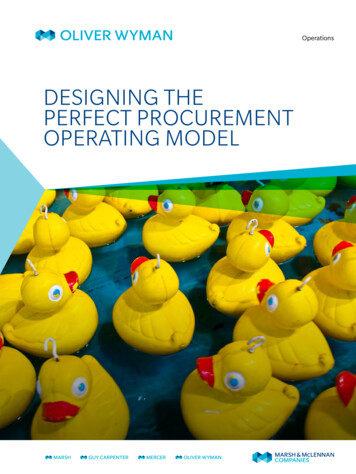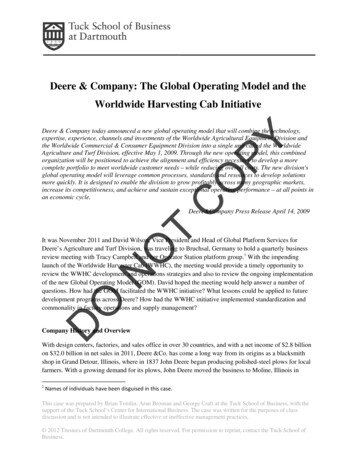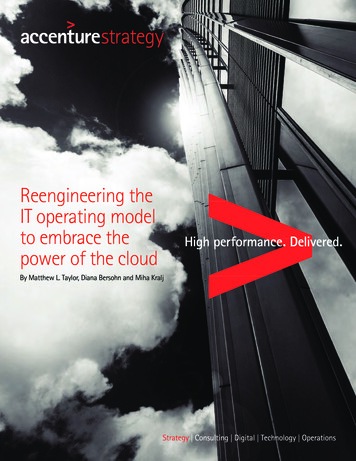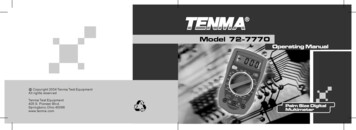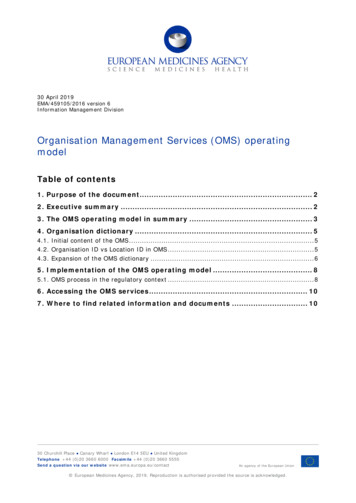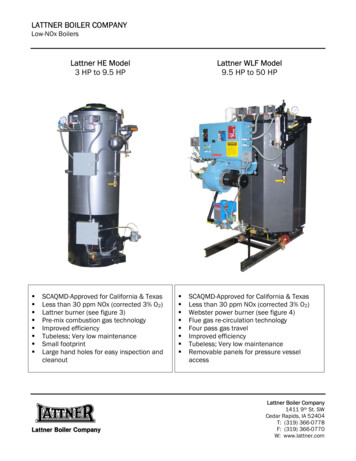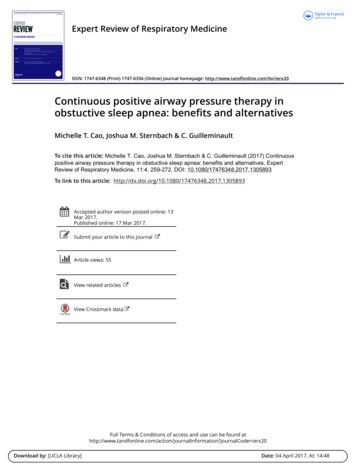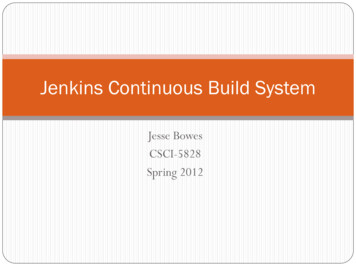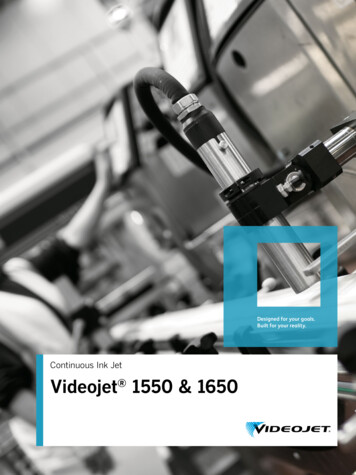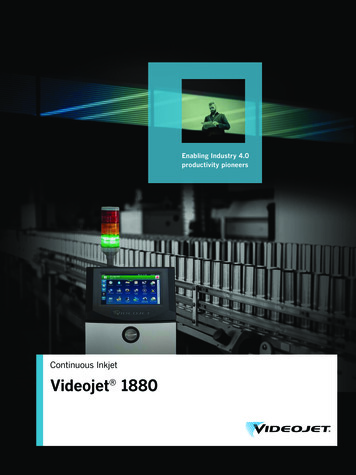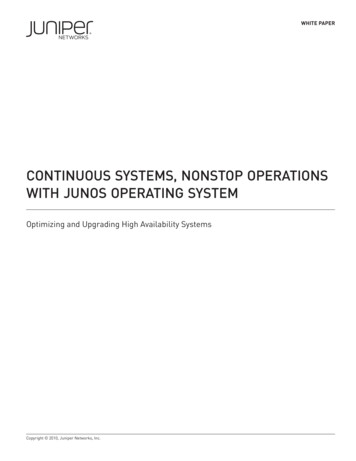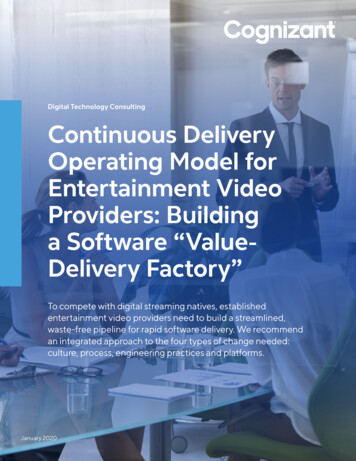
Transcription
Digital Technology ConsultingContinuous DeliveryOperating Model forEntertainment VideoProviders: Buildinga Software “ValueDelivery Factory”To compete with digital streaming natives, establishedentertainment video providers need to build a streamlined,waste-free pipeline for rapid software delivery. We recommendan integrated approach to the four types of change needed:culture, process, engineering practices and platforms.January 2020
Digital Technology ConsultingExecutive SummaryIncumbent entertainment conglomerates are scrambling todeliver higher-value software, faster.1 The World EconomicForum projects that 30% of total revenues will come from newdigital models by 2020.2To make the shift to digital, entertainment video providers need to create a “valuedelivery factory” — a streamlined, waste-free pipeline for rapidly delivering software withdemonstrable business value. In a 2018 study, DevOps Research and Assessment (DORA)reported that elite business performers outstripped laggards on the four software-deliverymetrics generally accepted as mattering most to business success:3, 4 Code release frequency: 46 times more frequent Lead time to change 2,555 times faster Change failure rate: 7 times lower Mean time to recover: 2,604 times fasterTransitioning to a continuous delivery operating model is not simple. It’s a majorundertaking that requires modernizing the entire content delivery value chain — from thefront-end system of engagement through the system of record. The complete developmentprocess, from concept to content, must revolve around what delivers value to the customer(targeted audience content, addressable advertising, or content distribution channels).This white paper, intended for entertainment video provider CIOs and leaders within lines ofbusiness, presents an incremental approach to building a value-delivery factory. We explainwhy a successful transition requires modernizing along four dimensions in parallel: teamsand culture, processes, engineering practices (including microservices and a modern dataarchitecture) and cloud-native platforms. To illustrate what success looks like, we sharethe experiences of a digital-first streaming service that has set the industry standard forcontinuous delivery operating models.2 / Continuous Delivery Operating Model for Entertainment Video Providers: Building a Software “Value-Delivery Factory”
Digital Technology ConsultingWhy legacy IT has become a liability forentertainment content providersEntertainment programmers rely on hundreds or thousands of applications for customerengagement, distribution management, content delivery, and more. Many of theseapplications were written decades ago, some in the 1970s. Unlike modern applicationsbuilt from reusable microservices, most legacy applications are monolithic. Adding orchanging a section of code — say, to introduce a new feature or connect with a newdistribution partner — can have the unexpected consequences described inThe Phoenix Project:5 Downtime that affects customers, the workforce and partners. Impeded agility. Even small changes take a long time because of the need forregression testing. Quality issues. Lack of transparency. Business leaders have little insight into which softwaredevelopment efforts drive business value. High costs. Maintaining legacy applications and the infrastructure they run onsqueezes IT budgets, inhibiting innovation.Continuous Delivery Operating Model for Entertainment Video Providers: Building a Software “Value-Delivery Factory” / 3
Digital Technology ConsultingImagining a continuous delivery operating model“Our highest priority is to satisfy the customer through the early andcontinuous delivery of valuable software.”— The Agile Manifesto6Competing with digital streaming natives takes more than oneoff projects to build a better product, interface or back-end system.Success requires a strategic approach: building a factory that canregularly produce software that delivers true business value asmeasured by sales, retention or cost reduction.The journey from traditional operating models to continuous delivery is not simple, and the pathway islittered with face-plants (see below). In our engagements with entertainment video providers aroundthe world, we’ve found that a successful transition to a continuous delivery model requires modernizingalong four dimensions in parallel: teams and culture, process, engineering, and platforms, including thedata architecture. Companies advance along each dimension incrementally, starting with the simplestimprovements and adding on.Roadblocks to a continuous delivery operating model “Bad Agile” – just the ceremonies (like Scrum meetings) without the rigor. High speed at the risk of quality. Abandonment of requirements because “We’re agile.” Waiting until development is complete to deploy to a production-like environment. Testing application code only, ignoring essential supporting services such as security and thecode used to provision and de-provision environments. Deploying software manually. Creating organizational chaos by changing too much at once.4 / Continuous Delivery Operating Model for Entertainment Video Providers: Building a Software “Value-Delivery Factory”
Digital Technology ConsultingIn our engagements withentertainment video providersaround the world, we’ve foundthat a successful transition toa continuous delivery modelrequires modernizing alongfour dimensions in parallel:teams and culture, process,engineering, and platforms,including the data architecture.Continuous Delivery Operating Model for Entertainment Video Providers: Building a Software “Value-Delivery Factory” / 5
Digital Technology ConsultingAn incremental journeyTackling the new process, organization and supporting technology inone go is a recipe for disaster because even small changes can haveunexpected consequences. Therefore, make small changes iterativelyand evaluate the impact at each step. Our recommendations: Start with a few carefully selected minimum viable products (MVPs) to build confidence, and then scalepragmatically from a base of demonstrated success. Aim to mature along all dimensions (teams and culture, process, practices and platforms) at roughly the samepace rather than going from zero to 60 on one dimension before tackling the next. For example, movinglegacy applications to a modern cloud platform without also teaching teams to build a continuous deliverypipeline will deliver little if any business value. Frequently assess whether changes have improved deployment frequency, lead time to change, changefailure rate and business value delivered. In a five-year study, DORA determined that organizations thatperform well against these metrics are twice as likely to exceed profitability, market share and productivitygoals.7 If your changes don’t improve these metrics, change tactics -- then measure again.Building and scaling the value-delivery factoryLEARN GAIN INSIGHT BUILDUNDERSTAND TEACH SFORMATION ENABLEMENTMEASUREWHAT MATTERSCHANGELEADERSHIP MINDSETFigure 16 / Creating Competitive Advantage from the Inside OutENABLECONTINUOUS LEARNINGTEACH THE ORGANIZATIONTO FIX ITSELF
Digital Technology ConsultingWe recommend that entertainment video providersshift to a continuous delivery operating model infour steps: baselining, forming teams, buildingMVPs, and scaling and optimizing.We recommend that entertainment video providers shift to a continuous delivery operating model in foursteps: baselining, forming teams, building MVPs, and scaling and optimizing. Different teams in a companyoften progress along the journey at a different pace depending on the slice of the business value stream thatthey are transforming. For example, a team building a new direct-to-consumer streaming product mightrapidly progress through all four steps, while a team that’s evaluating an old administration system mightdecide after the first step (baselining) to extract the data and then retire the system.1Conduct a baseline assessmentCompare software delivery performance to industry benchmarks. After establishing the baseline, set targetsfor the future state. The target, for example, might be to accelerate deployment frequency from months tominutes. Next, identify the impediments to reaching the future state. Impediments to deploying in minutes,for example, can include lack of version control and work-in-progress limits, manual testing, a monolithicapplication architecture and poor job satisfaction.2Form the first continuous delivery pipeline teamsStart with one or two Agile pod teams with six to eight members who have end-to-end ownership of productdelivery. Team members typically have expertise in product management, development, quality, the businessdomain and sometimes data.Show the pod what “good” looks like in terms of team structure and culture, Lean/Agile process, engineeringpractices and platforms. Provide basic training on modern processes (Scrum, extreme programming and theLean Startup methodology) and modern software engineering practices such as Build-Measure-Learn (BML),MVPs and an automated software development lifecycle.Strive to build a culture of continual experimentation. We’ve seen good results from “gamifying” the learningprocess with contests and rewards.Continuous Delivery Operating Model for Entertainment Video Providers: Building a Software “Value-Delivery Factory” / 7
Digital Technology Consulting3Build MVPsIdentify the first MVPs to deliver. It isn’t necessary to make an entire application cloud-native. Instead, askwhich parts of the legacy application portfolio will provide the greatest business value if they’re made cloudnative. Measure value in terms of subscriber growth and retention, cost reduction, traffic capacity, contentdelivery speed and so on. To tease out the value of existing software, we recommend using the Value StreamMapping (VSM) methodology.8, 9Give priority to frequently modified applications, as microservices can be changed more quickly. Keepin mind that an application that costs more to migrate to the cloud, such as policy management, mightalso deliver the highest lift. Conversely, an application that costs less to migrate, such as compensationmanagement, might deliver less lift.4Scale and optimizeTo scale the continuous delivery operating model across the company:Have the initial pipeline teams transfer knowledge to new teams by working side by side on an MVP. Thenew teams can then train others until the entire organization has learned Agile processes and culture, andmodern engineering practices.Work to continually improve along all four dimensions: culture and teams, process, engineering, andplatforms.Track the business value that the new software delivers. Measuring business value needs to become just asimportant a part of the product backlog as functional requirements. Writing code to capture business valuemetrics gives teams a solid basis to decide whether to pivot or persevere. By inserting a few lines of code, forexample, the team can measure the effect of a new feature or interface on the number of people who clickthrough to buy.Measure value in terms of subscriber growth andretention, cost reduction, traffic capacity, contentdelivery speed and so on.8 / Continuous Delivery Operating Model for Entertainment Video Providers: Building a Software “Value-Delivery Factory”
Digital Technology ConsultingQuick TakeMedia Services Provider BuildsSuccessful Continuous DeliveryOperating ModelOverviewNetflix has set the industry standard for delivering online video at scale. Beyond an innovative business model,engaging content, and world-class customer experience, Netflix’s robust engineering efforts in-house andcontinuous delivery operating model have changed the game. Other legacy entertainment video providers arenow obligated to perform at Netflix’s level to satisfy audience expectations.ApproachNetflix continually rethinks how data, engineering, and processes can be integrated to drive better businessresults. Key examples of this strategy include: Development of a fully open source, multi-cloud, continuous delivery platform, Spinnaker, that has enableddevelopment teams to release software changes quickly and confidently. 10 Platform architecture designed to utilize hundreds of microservices rather than a monolithic application. 11 Introduction of Chaos Monkey, the first in a series of tools collectively known as the Netflix Simian Army,incentivizing developers to build fault-tolerant systems.12 A DevOps culture permeating throughout the organization that uniquely provides guardrails, not gates, todevelopers. 13Outcomes Teams are empowered to take responsibility for their work and to make key decisions efficiently. Platform has the resiliency to handle server issues and unforeseen service outages. Market leadership through innovations like the pioneering of new interactive content for Bandersnatch.14 Industry influence via involvement in industry standardization and development efforts.Continuous Delivery Operating Model for Entertainment Video Providers: Building a Software “Value-Delivery Factory” / 9
Digital Technology ConsultingLooking aheadMany entertainment video providers will find it helpful to work with anexperienced partner to develop a backlog and coach the first several pods.We advise companies to: Start small. Change leadership mindset. Enable the team to continuously learn. Know what good looks like. Measure what matters. Make development decisions based onwhat delivers value to the customer. Create feedback loops, measured inminutes or hours. Build a community of engineering excellence. Continuously improve.A successful transition to continuous delivery requires incremental modernization of teams and culture,process, engineering and platforms. Decide whether to pivot or persevere by continually monitoring themetrics that matter most to business success — release frequency, lead time to change, change failure rateand mean time to recover.Endnotes1Cynthia Littleton,. “How Hollywood Is Racing to Catch Up With Netflix,” Variety, 202910463/.2“How to Disrupt Yourself,” World Economic Forum, January tion/how-to-disrupt-yourself/.3DevOps Research and Assessment (DORA), 2018 State of DevOps Report.4Nicole Forsgren, Jez Humble, Gene Kim, Accelerate: The Science of Lean Software and DevOps: Building and Scaling HighPerforming Technology Organizations, 2018.5Gene Kim, Kevin Behr, James Spafford, The Phoenix Project: A Novel About IT, DevOps, and Helping Your Business Win, ITRevolution Press, 2013.6Agile Alliance, Agile Manifesto.7DevOps Research and Assessment (DORA), 2018 State of DevOps Report.8Karen Martin and Mike Osterling, Value-Stream Mapping: How to Visualize Work and Align Leadership for OrganizationalTransformation, McGraw-Hill Education, 2013.9Mark Schwartz, The Art of Business Value, IT Revolution Press, 2016.10Swapnil Bhartiya, “How Netflix Built Spinnaker, a High-Velocity Continuous Delivery Platform,” The New Stack, January 5, �Why You Can’t Talk About Microservices Without Mentioning Netflix,” SmartBear Software, December 8, nt-talk-about-microservices-without-ment/.12“The Netflix Simian Army,” Medium, Netflix Technology Blog, July 19, ix-simian-army-16e57fbab116.13“A Case Study of DevOps at Netflix,” Amido, June 12, 2018, etflix/.14Jesse Damiani, “Black Mirror: Bandersnatch Could Become Netflix’s Secret Marketing Weapon, “ The Verge, January 2, ting.10 / Continuous Delivery Operating Model for Entertainment Video Providers: Building a Software “Value-Delivery Factory”
Digital Technology ConsultingAbout the authorsCarol HouleVP of ConsultingAs the global market leader for Cognizant Digital Technology Consulting, her team focuses onhelping clients transform digitally. They advise clients on improving their teams/culture, process,engineering practices and platforms to achieve improved quality, time to market, customersatisfaction, productivity and morale. Her team applies Lean principles to the value stream, enablingdynamic, learning organizations that continually reinforce high-trust cultural norms. The resultis maximized business outcomes, developer productivity and value delivered to end customers.Carol is known for connecting people and concepts to solve complex business problems. Prior tojoining Cognizant, Carol was an IT Transformation Partner at Dell Technologies, and she currently serves on the board of directors of abanking and insurance company. She can be reached at carol.houle@cognizant.com linkedin.com/in/carol-houle-60aa9110.Allen RingelAVP of Digital Technology ConsultingAllen leads Cognizant’s Lean/Agile practice. He brings more than 20 years of experience inenterprise software development and more than 15 years as a thought leader and consultantin Lean/Agile methodologies. Before joining Cognizant, Allen served for 18 years at Intel, wherehe led one of the largest Agile transformations, building an organization of 500 global teamsusing the Scaled Agile Framework (SAFe). During the process he coached thousands of Scrumteams and applied Lean/Agile to create a sustainable, self-organizing and learning organization.Over the course of his career, Allen has been a developer, architect, program manager, peoplemanager, organizational change agent, teacher, coach and consultant. He can be reached at allen.ringel@cognizant.com linkedin.com/in/allenringel.Michael WagnerAVP of Digital Transformation through Enterprise DevOps andModern Software EngineeringMichael has previously worked at Microsoft, start-ups, F500s and consulting organizationsfor the last 30 years. He has been an entrepreneur, enterprise architect, software engineer,CTO, President, executive coach and writer. Working from New York City, he helps establishedorganizations survive then thrive where software is eating the world. To this end, he coachesbusiness and technology leadership on how to execute upon the DevOps movement at scale thatfuses people, process and technology into 21st century digital economy-coded businesses. Hisjourney spans several industries, including life sciences, financial services, technology and media. He can be reached atmichael.wagner@cognizant.com linkedin.com/in/michaelstevenwagner/.Continuous Delivery Operating Model for Entertainment Video Providers: Building a Software “Value-Delivery Factory” / 11
Digital Systems & Technology ConsultingCognizant’s Digital Technology Consulting (DTC) Practice provides advisory consulting infused with cross-functional capabilities to enable enterprise-widedigital transformation. DTC’s core capabilities span the software and platform landscape. We leverage Agile/DevOps, security and automation to enablebusinesses to unlock digital capabilities across their front, middle and back offices. Our objective is to help clients eradicate release weekends by enablingcontinuous delivery. This ultimately helps them to achieve improved end-customer experiences, lower operating costs, improve time to market, enhanceoperational stability and create a happier workplace. To learn more, visit us at www.cognizant.com/consulting.About CognizantCognizant (Nasdaq-100: CTSH) is one of the world’s leading professional services companies, transforming clients’ business, operating and technologymodels for the digital era. Our unique in
10 / Continuous Delivery Operating Model for Entertainment Video Providers: Building a Software “Value-Delivery Factory” Digital Technology Consulting Looking ahead Many entertainment video providers will find it helpful to work with an experienced partner to develop a backlog and coach the fir
